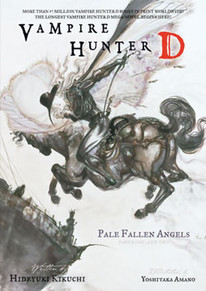Review
by Theron Martin,Vampire Hunter D
Novel 11 - Pale Fallen Angels
| Synopsis: |  |
||
D, the gorgeous and mighty dhampir Vampire Hunter, has spent many a year hunting down and destroying the vampiric Nobility, but never before has he had a task like this: escort the Baron Byron Balasz, a Noble, to the domain of Krauhausen, where the good Baron intends to kill his own father. Though the Baron seems quite capable on his own, and does harbor a number of unusual traits, several other Hunters intent on killing him stand in his path, in addition to the assassins dispatched under his father's orders, common bandits, a long-imprisoned relic of wars from thousands of years ago, and the odd uncontrolled monstrosity. That is where D comes in. Complicating matters are a number of fellow travelers D and the Baron pick up along the way, including the haughty Noblewoman Miska, the former magician's assistant Taki, and the young brother-sister acrobat duo of May and Hugh. Can the two Nobles stick to their agreement not to drink human blood on the journey? And will everyone get through the trip alive? |
|||
| Review: | |||
Pale Fallen Angels was originally the ninth of the Vampire Hunter D novels, but its first two books, which total 295 pages, compose the 11th volume released by Dark Horse Books. (The second two books of this four-book story will compose the 12th volume, which is due out in the U.S. in March.) Although the main gimmick in the plot – that D is working for a Noble this time, rather than hunting him – marks a dramatic departure from previous novels in the series, the story content, execution, and style remain typical of what has been seen in previous novels. That is both the novel's greatest strength and its greatest weakness. As has generally been the case in earlier novels, writer Hideyuki Kikuchi is at his best when describing exotic future technology, threatening monstrosities, individuals with bizarre powers, and high-powered action scenes, and these pages offer a bountiful amount of such content. He also still excels at portraying the fearful awe that the Nobility can command. Where this particular novel runs into trouble is in its thin plot. “D accompanies a Noble on a mission to kill his own father and picks up others along the way while dealing with deadly threats” pretty much sums up the entirety of the book, turning the content into one of those old video games where you travel along a path picking up companions and defeating monsters while carrying out a quest. A couple of kidnappings try to complicate matters, but overall the format can become tiring after a while, as can D's seeming invincibility; he clearly subscribes to the Steven Segal School of Fighting, in the sense that he can beat anyone down without ever seeming to be seriously threatened or challenged. A mostly flat supporting cast does not help, although the Baron's behavior is odd enough to spark some interest. Pale Fallen Angels also suffers from a full boatload of the annoying idiosyncrasies inherent in Kikuchi's writing style. He overemphasizes the unparalleled, breathtaking, entrancing beauty of D so much that after just a few dozen pages readers may want to beat Kikuchi over the head with a blunt instrument just to get him to stop (but he never does). His frequent use of unnecessary introductory phrases like “needless to say” and “it goes without saying that. . .” also quickly becomes irksome, and his conversational style, where he regularly poses questions to the reader about some circumstance in the story, may be too casual for some tastes. And, of course, D has all of the personality of a rock, albeit a very, very skilled and powerful rock. The few times he does actually try to show character, it seems awkward, as if Kikuchi is never quite sure how far he wants to go with D. Another problem is the occasional ineloquent use of idioms, which, while not exactly wrongly used, nonetheless pop up at odd times to disrupt the smooth flow of the writing. This is a common problem in translated Japanese novels, though, so it is either a general Japanese stylistic issue or a translation issue. The translation otherwise works fine and lacks the occasional grammatical error seen in the earliest volumes. Yoshitake Amano once again provides the highly stylized interior and cover illustrations and Dark Horse once again includes a lengthy preview of the next novel at the end as well as a three-page author Postscript and brief bio blurbs on the author and illustrator. In some senses the Vampire Hunter D novels resemble Robert E. Howard's early Conan the Barbarian short stories: the exact setting and details might change from story to story, and the overall story only very gradually progresses, but each story pretty much amounts to Conan being Conan as he adventures across the fantastic world of the Hyborian Age, leaving much graphic carnage in his wake. The D novels offer that same kind of familiar pulp novel feel. They do not take bold risks, instead focusing merely on reproducing a well-proven formula. That (and, of course, the whole vampire thing) is the reason why the franchise has been so successful. Like its predecessors, this one may not satisfy a reader expecting something sophisticated, but it serves well enough as comfort food. |
| Grade: | |||
|
Overall : C+
Story : C+
Art : C
+ Lots of cool tech and monsters, plentiful action. |
|||
|
discuss this in the forum (4 posts) |
this article has been modified since it was originally posted; see change history |
|||
| Production Info: | ||
|
Full encyclopedia details about Release information about |
||